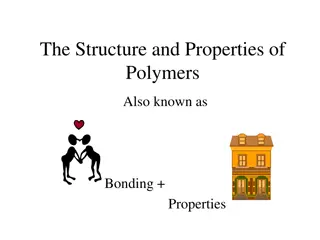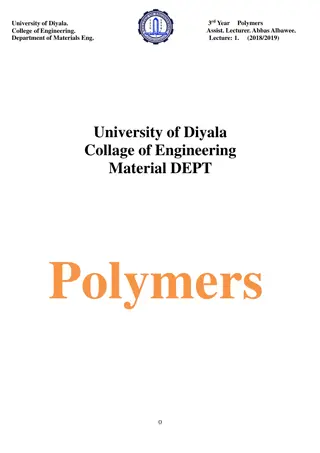Understanding Polymers and Their Properties
Polymers are long chains of repeating monomers, with both natural and synthetic varieties. Natural polymers include silk, cellulose, and DNA, while synthetic ones encompass plastics, fibers, and elastomers. The properties of polymers, such as molar mass and monomer structure, determine their functions. Cross-linking, as seen in vulcanization, enhances polymer strength and durability. Detecting cross-linking in polymers involves various methods like NMR and microscopy.
Download Presentation

Please find below an Image/Link to download the presentation.
The content on the website is provided AS IS for your information and personal use only. It may not be sold, licensed, or shared on other websites without obtaining consent from the author. Download presentation by click this link. If you encounter any issues during the download, it is possible that the publisher has removed the file from their server.
E N D
Presentation Transcript
What are Polymers? Long chains of repeating monomers
Natural Polymers Silk/Wool Cellulose/Lignin Starches/Polysaccharides DNA/RNA Rubber Proteins
Synthetic Polymers Plastics Synthetic Fibers (nylon, polyester, etc.) Films Elastomers Adhesives Synthetic rubbers
Properties of Polymers Large molar masses Structure of monomer determines properties of polymer (and what function it may serve) Rubber: liquid at room temperature
Glue Polymer composed of primarily collagen
Glass-Transition Temperature temperature at which a polymer transitions from crystalline to amorphous elastomers (such as rubber) have relatively low TG and are amorphous under standard conditions
Cross-linking 1839 Goodyear - vulcanization By covalently connecting polymer chains, solid-like properties can be obtained Tensile strength, stiffness, toughness, etc.
Is the polymer crosslinked? Nuclear magnetic resonance Diffusion tests Scanning electron microscope Swell test























